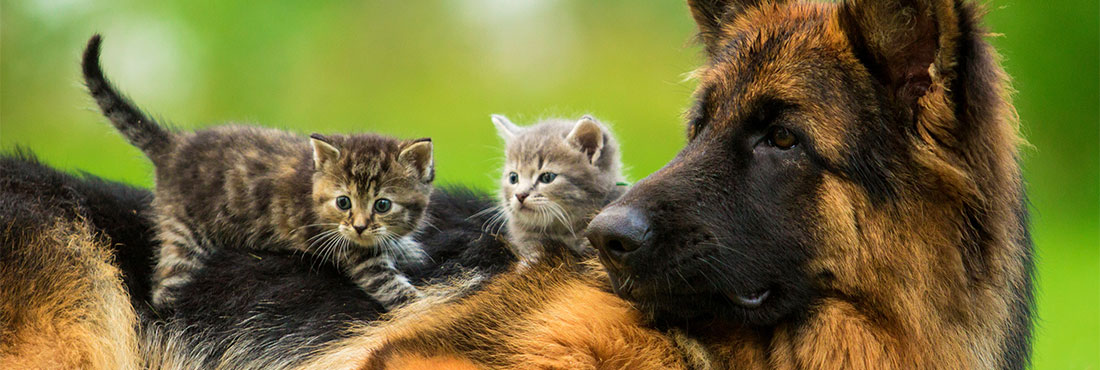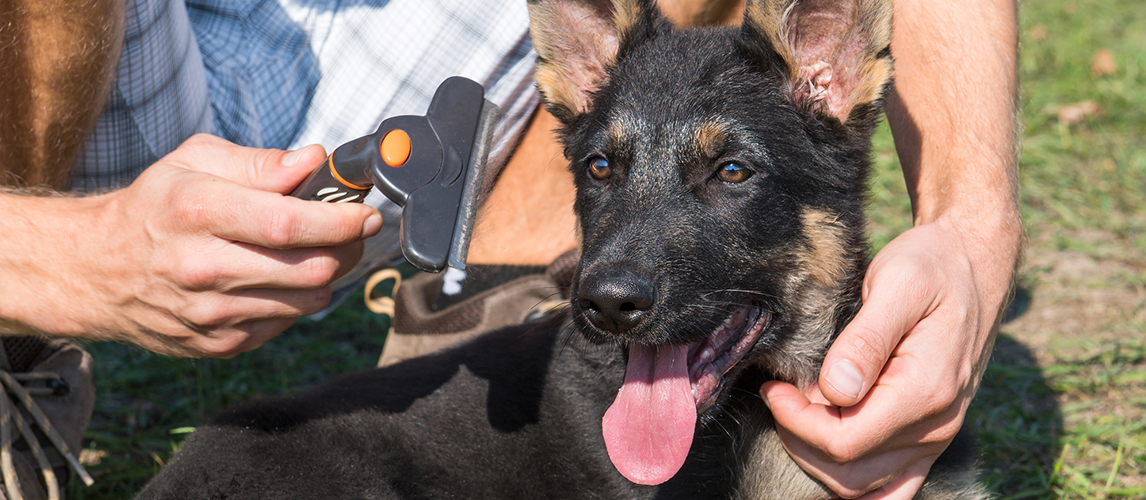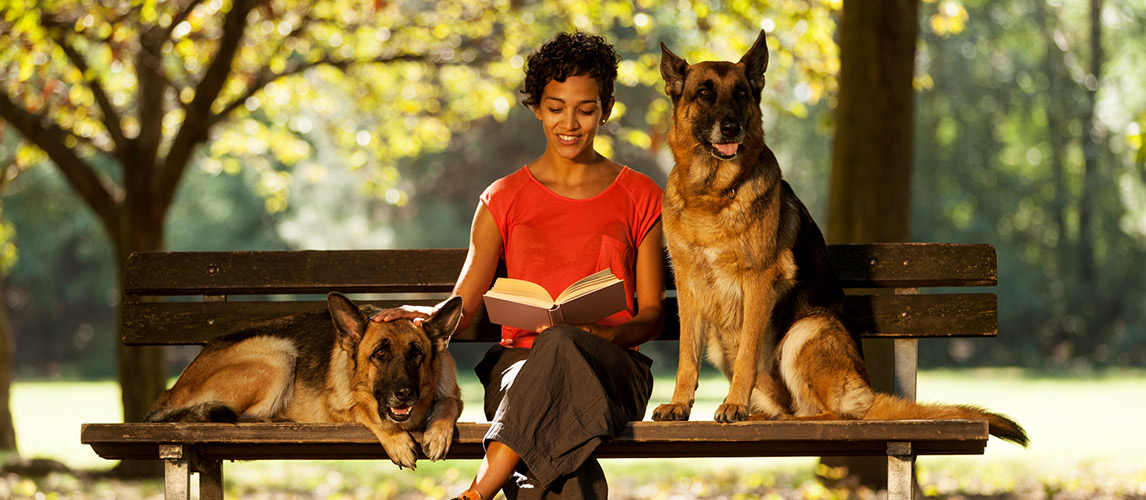We all know that the relationship between some cats and dogs can be tricky, but it’s possible for canines and felines to live harmoniously. And when it comes to dogs, some breeds are more amenable to living with cats than others.
Despite their size and guard dog reputation, the German Shepherd dog – or GSD – can be a happy cat lover. But they do need appropriate training, socialization and a well-managed introduction.
We explore the question ‘do German Shepherds get along with cats?’ and look at how your kit and GSD can get on like a house on fire.
Are German Shepherds Good with Cats?
Compared to other large dog breeds with a tough reputation, the German Shepherd has a natural way with cats. However, it shouldn’t be assumed that every GSD is feline-friendly, as it also depends on other factors such as their individual personality. But, as the German Shepherd is generally less aggressive than many other large breeds, it is possible, with the right socialization, for them to get along with cats.
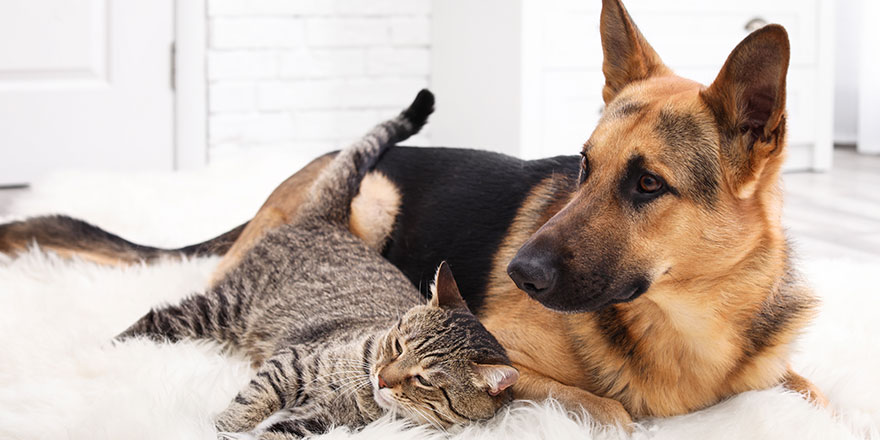
About the German Shepherd
German Shepherds were originally herding dogs, bred to herd sheep, keeping their flock together by nipping at their heels. And they can still have a natural instinct to chase and herd as well as defend against any perceived threats.
They are also large, strong animals – a typical adult German Shepherd weighs up to 40 kilos – and are protective towards their humans so can demonstrate some dominant behaviors. While their general demeanor shouldn’t be aggressive, German Shepherds are also assertive animals that could alarm and spook your cat.
GSD personality
Intelligent, brave, and protective, the German Shepherd can also be one of the most lovable and loyal dog breeds. They are also highly trainable, which is why you see so many GSDs working within the Services.
As a family pet, they get along well with children and love to play. And if they are socialized and trained well, they can also come to see other animals, including cats, as part of their family.
They do have high energy needs so require plenty of exercise as well as mental stimulation. And, while they are good with strangers, they can be cautious until they get to know you.
Their prey instinct
As a working dog, German Shepherds have a high prey drive. This is an in-built response to potentially chase any fluffy animals they see. What they are doing is herding, although this behavior can be misinterpreted by the animal being chased, leading to unwanted, and unpleasant, altercations.
Understanding this ‘prey instinct’ is essential when working to get German Shepherds and cats to co-habit peacefully. A GSD will not chase or herd all the time but knowing that your dog has an inclination means you can take preventative action.
Trainability
With their smart, switched-on brains, German Shepherds are a dog breed that’s a pleasure to train. And, when it comes to introducing them to life with a cat, this can be a real bonus. As well as their herding instinct, the GSD has a desire to please their pet owners, which can be used to your advantage.
If you can train your German Shepherd to respond well to a cat, and enjoy having them around, then you can help a GSD see your feline as part of their family pack.
Key Factors to Consider
When it comes to whether a German Shepherd can get along with cats, it’s important to also take the following into consideration.
Socialization
Has the GSD been socialized properly from an early age? Whether it’s at home or out and about, you want any dog to respond well to other people, pets, or animals they may meet.
With their intelligence and highly trainable personality, German Shepherds, especially a German Shepherd puppy, respond well to training. And with socialization, you have a good chance of bringing up a cat-friendly, or at least cat-tolerant, dog.
According to the American Kennel Club, the earlier you start socialization training, the better – ideally from the first three months of a German Shepherd’s life. And this involves introducing them to as many new people and situations as possible, in a safe and supportive way. The more you positively expose your puppy or new dog to these situations, the more confident and less reactive your well socialized German Shepherd will be when faced with a new encounter.
Age
The younger your German Shepherd is when a cat is brought into the animal’s environment, the better the chances that they will get along. And if it’s a kitten, even better, as young animals are more curious, playful, and less set in their ways.
But it’s still possible to introduce a cat to the home of an older German Shepherd, especially if they have previous positive experiences with felines. But even if it is the first time an adult GSD has been asked to share their home with a cat, it can still have a happy ending.
Temperament
While German Shepherds can get along with cats, every dog is an individual. And so, it’s essential you understand your dog’s temperament before making the decision to bring a cat home.
An overly reactive, aggressive, or possessive dog, or a German Shepherd with herding instincts that cannot be confidently managed may not be the best housemate for a new cat.
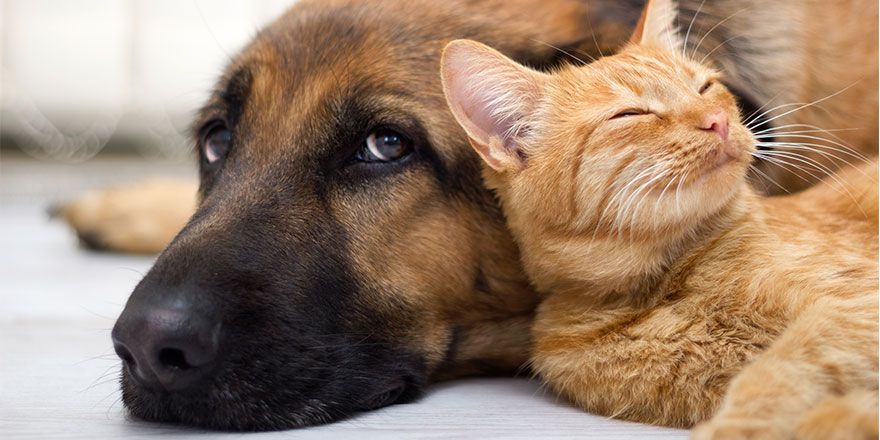
How to Introduce Your German Shepherd to Your Cats
So, now we know that it is more than possible for a German Shepherd to happily cohabit with a cat, here’s our step-by-step guide to introducing your GSD to your cat or cats.
Supervision is a must
Any interactions between your two pets must always be supervised. And your GSD must be trained and have the core commands, such as ‘stay’ and ‘come’ before you start.
Take it slowly
Don’t force or rush the process, as you want to introduce your dog and cat gradually and calmly, without scaring or triggering negative behavior in either animal. A slow introduction process is best for all concerned and ensures you have control at every step.
Swap scents
You should start the process of getting them to know each other ‘remotely’ by swapping their scents.
Using a clean cloth for each animal, you need to capture their unique scent. For a cat, this means rubbing the cloth on the top of its head, chin, and cheeks. For dogs, the best place is from their sides and armpit area.
Now take the cat cloth to your German Shepherd, and the dog cloth to your cat, and with your animals in separate rooms, allow them in their own time to sniff and explore. Observe each pet as they sniff the cloth, to see how they behave. Initially, your cat may appear anxious or apprehensive, while your dog could become excited.
Repeat this process with freshly scented cloths each day until you observe more calm and relaxed body language in both animals.
Separated introduction
Once your pets appear comfortable in the presence of the scented cloths, you are ready to progress to a physical introduction. At this stage, they must still be separated but enabled to see each other. You can do this by putting them on either side of a closed glass door, a secure baby gate or pet gate.
Make the first separate introduction short, no more than a few minutes, observing their reactions. If all goes well, do this separated introduction for five minutes a day for a few days or until you feel happy that they are both in a good place.
This invaluable ‘face time’ starts to build on recognition between the pair. And don’t forget to gently praise and treat reward calm behavior as well as any signs of friendly curiosity.
Bringing them together
Once you are happy your pets are accustomed to each other and are demonstrating calm behavior, you can start to bring them physically together. Start off with the pet gate and a secure, indoor environment so they can see and smell each other. And don’t forget to reward good behavior with treats.
At this stage, it’s a good idea to have your German Shepherd on a leash for control if needed. When you are ready, let your leashed dog gently smell your cat, allowing your feline to move away if need be. Keep this calm leashed interaction going for short daily sessions for several days, extending the leash gradually to give your dog a little more freedom.
Your aim is to have both animals calm and not reactive in each other’s presence. By this stage, you will have a good idea as to whether your German Shepherd is going to get along with cats!
Off the leash
Keep observing your cat as well as your dog, as a skittish cat will run, and that has the potential to trigger your GSD’s herding instinct. The decision to take your dog off the leash should be based as much on how calm your kit is, as it is on how well-behaved your dog is being.
Only when you are happy to do so, pop your cat into a cat carrier and then slowly remove your dog’s leash. You can progress to letting the cat out of the carrier once you are satisfied with how your GSD is behaving. Let your cat lead the situation and stay close and ready to react if things suddenly escalate. Ideally, at this stage, your kit will be showing no signs of anxiety and your German Shepherd is calm, friendly, and showing no signs of trying to herd.
If this is the case, you have made a huge leap forward. The next few months should now be spent gradually increasing the time your new canine/feline BFFs are together. But it must always be under supervision until you have no concerns over leaving them alone.
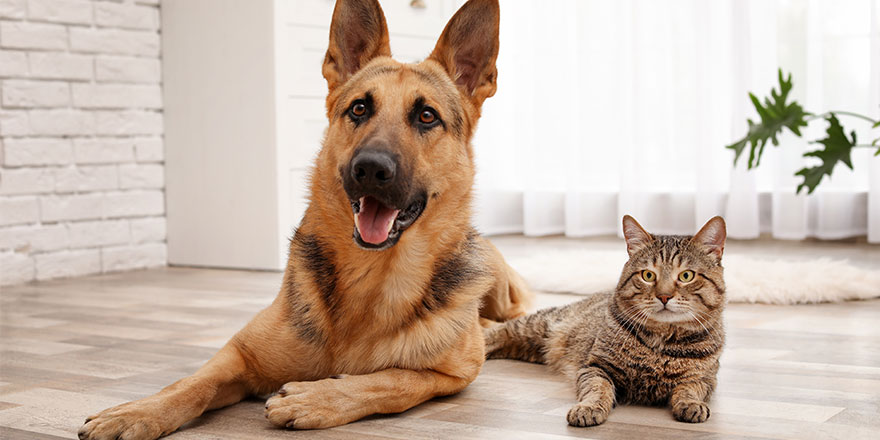
Tips to Help Your German Shepherd Dog and Cat Get Along
It may seem a bit of an arduous task introducing your GSD to your pet cat, but it is worth it. Here are a few extra tips for ensuring your German Shepherd and cat get along:
Keep your dog well exercised – before each introduction, make sure you have taken your dog out for a good walk or play to reduce their energy levels and get them in a calmer place. And making sure they are well-fed can leave them feeling more content and amenable.
Reward not punishment – positive reinforcement is the only way to go with both socializing your German Shepherd and introducing them to another family pet. Yelling or punishing your pooch is no way to behave and can actually trigger a negative response in your cat or dog.
Instead, plenty of verbal praise and tasty treats when they do good will reinforce their good behavior.
Don’t force things – rushing into things or forcing the situation can make the whole interaction go downhill fast. Always bear in mind the individual personalities of each pet and progress the introduction at their pace.
Give your GSD lots of attention – balancing attention between each animal is vital. As the smaller and potentially most vulnerable pet, your instinct may be to reassure your cat the most. But this could trigger jealousy in your German Shepherd. Ensure your pooch gets all the love and attention he needs to keep him focused and happy – a good grooming session can also cement your bond.
Give them space – when going through each stage of introducing your German Shepherd to a cat, make sure each animal has their own space and the opportunity to safely retreat if needed. For your kit, this can be a tall cat tree or a separate room, and for your dog, a crate or backyard.
And finally, be patient – take your time and be prepared to move back a stage if need be. It’s not a race and you need to make the introduction process as positive, calm, and stress-free as possible. Patience means you set solid foundations for a happy relationship between your cat and German Shepherd. And that ultimately means a happy household!
Sources:
- Puppy Socialization: Why, When, and How to Do It Right – American Kennel Club
FAQs
While not strictly scared, German Shepherds, like many dogs, can be naturally wary of cats which can cause them to be unsure and nervous in their presence. Early socialization can make a difference as it means your GSD will grow up used to being around other pets.
A GSD injuring or killing a cat is not unknown, whether that’s in the home or a cat that has strayed on to the dog’s territory. And it is because the GSD can be aggressive or chase cats, partly due to their working dog instinct to herd.
But the risk can be reduced or eliminated altogether if you German Shepherd has had proper training and has been socialized from an early age. If necessary, seek the input of a dog trainer.
There are some breeds known to generally live quite happily with cats and other animals, including Beagles, Labradors, and Golden Retrievers. But even then, depending on the cat, a harmonious home life cannot always be guaranteed.

